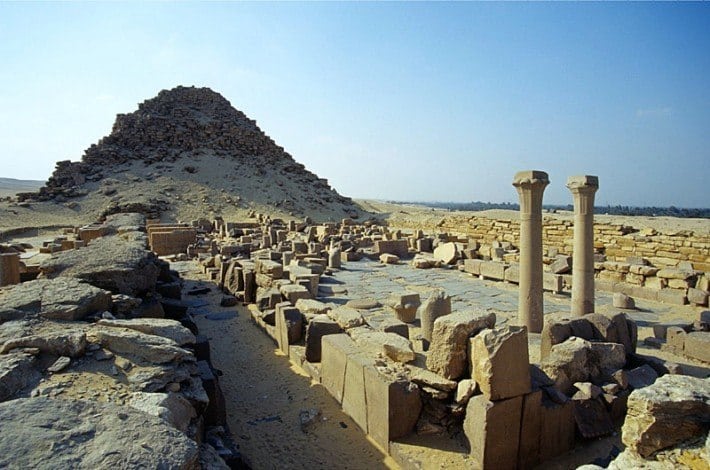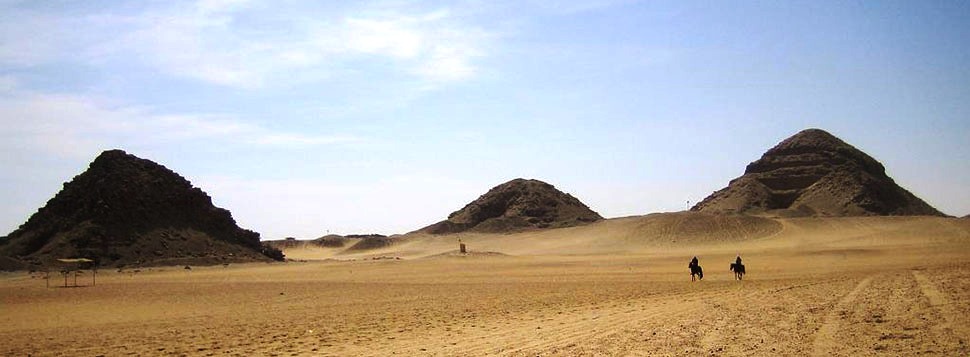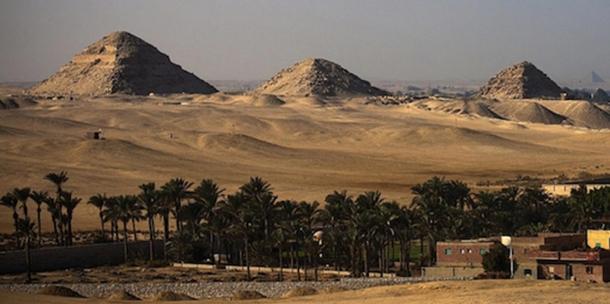Monuments Sight Seeing Attractions Egypt Abusir Necropolis
Monuments Sight Seeing Attractions Egypt Abusir Necropolis Since 1989, in the area now known as Abusir South, which is just a little to the north-west of Saqqara, the Czech Institute of Egyptology have been investigating the private tombs of officials and priests of the Old Kingdom. Some of these tombs had been visited by Lepsius in the mid-1800s, but have since fallen into a poor state of preservation.
The Czech team are concentrating on gaining a deeper understanding of the development of the necropolis by studying not only the royal monuments but also Old Kingdom (Dynasty III-VI) and Saite-Persian (Dynasties XXVI-XXX) cemeteries.

Tomb of Udjahorresnet
The Czech Institute began work in 1980 at South-West Abusir, investigating tombs in an area which Lepsius had designated as the site of another pyramid (Lepsius XXVII).
A line of large Saite-Persian shaft tombs runs from here, south-east towards the Saqqara Serapeum and after investigation the team found the ‘Lepsius pyramid’ was actually a complex tomb of an important official during the Persian era.
The owner’s name is Udjahorresnet, a priest at Sais during the reigns of Cambyses and Darius I and whose statue with an autobiographical text is well known from the Vatican Museum.
His tomb shaft, which had been filed with sand, was cleared, but robbers had already struck and little was found in the burial chamber except two damaged limestone and basalt sarcophagi.
Tomb of Kaaper
Among the most important monuments to be investigated is the tomb of Kaaper, which was excavated and documented in 1989.
Kaaper was a ‘Scribe of the Royal Armies’ (probably on the Eastern Frontier) during early Dynasty V.
Kaaper’s tomb has a large rectangular superstructure encased in limestone, with a façade once decorated with portrayals of the deceased.
The rectangular offering chapel contains the remains of a false door with a red granite altar sunk into the floor before it and a serdab behind it.
An L-shaped interior chamber in the south-west corner of the tomb also contains a false door.
Many reliefs from Kaaper’s mastaba have been identified in museums around the world.
Tomb of Fetekhy
In 1991 the Czech team located the Old Kingdom tomb of Fetekhy which had been previously documented by Lepsius and subsequently lost.
Fetekhy’s tomb once contained beautiful painted decoration which included unusual detailed market scenes which were reproduced by Lepsius.

Tomb of Qar
Fetekhy’s tomb is surrounded by an Old Kingdom cemetery in which many other important tombs were found.
In 1995 the Czech team excavated the family tomb of Qar, a previously unknown judge and vizier of Dynasty VI, who was involved in the administration of the pyramid cults of Pepy I, Meryre and Neferkare.
The tomb complex has been excavated and found to contain two tomb chapels, one decorated with reliefs of the deceased and a massive red granite false door which has now been restored.
A sloping passage in the south-eastern corner of an open court gives access to a single burial chamber where a huge limestone sarcophagus was found.
Epigraphic and restoration work in the mastaba of Qar is still continuing.
The mastaba is not open to visitors.
Several smaller chapels were found to the north of Qar’s tomb, belonging to his sons Qar and Senedjemib. These chapels had curiously been destroyed by smashing and scattering the decorated blocks – thought to be a deliberate act.
Tomb of Iufaa
Work began in 1995 on the second shaft tomb, a little to the south-east of Udjahorresnet’s monument.
The owner, Iufaa was a previously unknown official of the Persian Period, who held the titles of ‘Lector Priest and Controller of Palaces’.
A mudbrick enclosure wall was revealed which once would have contained stelae in niches, but only fragments of one limestone stela was found.
Further investigation of the shafts in subsequent seasons has revealed rich rewards – the first intact burial to be discovered since Howard Carter excavated the tomb of Tutankhamun.
Unfortunately the tomb shaft had been badly damaged by a series of earthquakes in 1992 and 1996 and further excavation required the construction of a large concrete coffer to protect the vaulted roof of the burial chamber.
The massive shaft is 28m deep and it was at the bottom of the shaft that Iufaa’s burial chamber was discovered, complete with a huge white limestone sealed sarcophagus.
Around the sarcophagus the Czech team, directed by Miroslav Verner, found a complete set of burial equipment, including canopic jars, furniture, vessels, inscribed magical bricks and a full set of 408 blue faience shabti figures of the finest quality.
In February 1998 the limestone sarcophagus lid was raised with due ceremony and media coverage, to reveal a second anthropoid sarcophagus of finely carved dark green schist, hidden by a peculiar layer of mudbricks.
The anthropoid sarcophagus had a lid carved in the image of Iufaa as Osiris, wearing a false beard and wig or head covering, and with vertical rows of incised hieroglyphic inscriptions down its length.
This in turn was uncovered and when opened was found to contain a badly decayed wooden coffin covered with a layer of painted stucco.
Iufaa’s mummy, inside the inner coffin, was covered by a bead net shroud, but the mummy was also too badly damaged by time and humidity to be saved.
The remains of the decomposed mummy in its linen wrappings with portions of gilding still seen on the face, were transferred to Giza to be studied, and found to be the body of a male at around 30 years of age at death (from the preliminary examinations).
It is intended that the body of Iufaa will eventually be returned to his tomb and once more laid to rest.
Since 1998 the Czech team have continued work in the tomb of Iufaa, unearthing further structures around the area of the main shaft, where a complex of chambers probably connected to the mortuary cult of the deceased have been found.
A sloping corridor leads from the chambers to the tomb shaft and two wooden coffins were found here, one containing the body of an elderly man and the other belonging to a lady named Imakh-kher-(t)-resent, who were probably relatives of Iufaa.
Burial equipment has also been found here, including canopic jars and a set of 405 shabti figures. Consolidation inside the burial chamber itself has also continued with restoration of the extensive inscribed reliefs on the chamber’s walls.
The tomb is not currently open to visitors, but is scheduled by the SCA to be open in the future.
Tomb of Padihot
Near the eastern side of the tomb of Iufaa, another shaft was uncovered by the Czech Institute in their 2000-2001 season. A small decorated burial chamber revealed the name of its owner, Padihot whose only title was ‘Royal Acquaintance’.
In the corridor which links the shaft to the burial chamber an Arabic inscription in Kufic script was found scratched on the wall.
The tomb was robbed and found to contain only a few shabtis scattered in the burial chamber.
Tomb of Inty
To the south of Qar’s tomb the Czech team have excavated (during 2000-2001) the tomb of Inty, a Dynasty VI official and ‘most favoured son’ of the Vizier Qar.
His titles include ‘Judge, Keeper of Nekhen, Supervisor of Prophets of the Pyramid of Teti, Tenant of the Pyramid of Teti, Judge of the Six Great Courts and Secretary of the Judgement of the Six Great Courts’.
Excavations have so far revealed a superstructure constructed from mudbrick and encased in limestone slabs.
It’s decorated entrance in the northern wall leads to a small open court, a tomb chapel, a vaulted serdab and a large open court.
The façade, small court and chapel have been reconstructed and covered with a reinforced concrete roof.
In the 2002 season the burial shafts were investigated and recorded and the largest of these has been excavated.
Pottery, alabaster bowls and copper tools and vessels have been found in the burial chamber where a large limestone sarcophagus lies to the east of a false door. Several imported jars were also found in the tomb.
Inti’s tomb contains many fine reliefs, but the most important discovery from the tomb is a seated limestone statue of an official, Nefer, found in the entrance to the chapel.
The importance of this is that not only was it the first statue of an official to be found in this area, but it is one of the earlier attestations that the tomb’s mortuary cult was shared by another individual. The statue of Nefer has been transferred to the Egyptian Museum in Cairo. The tomb is not open to visitors.


